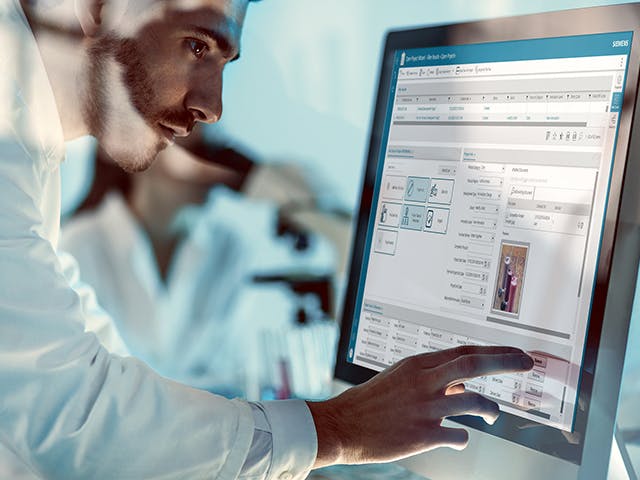SIMATIC IT MES software
SIMATIC IT Unified Architecture Foundation (UAF) is a platform for building, running, and managing a modern MOM ecosystem, targeting the current and future transformational technologies that are shaping the future of manufacturing. At the core of SIMATIC IT UAF is a unified manufacturing operation data bus that provides a common backbone for the integration of legacy applications while also offering the first fundamental step towards a unified, integrated system.
SIMATIC IT UAF logics are executed in a distributed execution environment designed to run on small- to large-scale computing hardware. Data is persisted in a standard relational database management system (RDBMS).
SIMATIC IT UAF is constructed around domain-driven design (DDD). Application data, services, and events are defined by a model setting out application structure and exposed as metadata at any layer.
SIMATIC IT UAF features an event-driven service-oriented architecture (SOA). Its application is composed of modular functional blocks, deployed and managed by the execution environment, intercommunicating with events and messages. This architecture allows modular application management, thus facilitating functional expansion.
SIMATIC IT UAF is designed to scale up to ensure a high level of performance throughout the application lifecycle, supporting a growing load of users and data as well as expansion on a functional level.
Related Product: Opcenter Execution
SIMATIC IT Unified Architecture Discrete Manufacturing
See Opcenter Execution Discrete
SIMATIC IT Unified Architecture Discrete Manufacturing (UA Discrete Manufacturing) is the specialized manufacturing execution system addressing the needs of the discrete industry market. It is designed to meet the needs of industries in which macro-areas are dedicated to executing sequential discrete manufacturing functions to produce the desired product. These include:
- Automotive tier suppliers
- Aerospace and defense tier suppliers
- Energy and utility systems manufacturers
- Industrial machinery and heavy equipment manufacturers
- Manufacturers of white goods and home appliances
- Complex parts manufacturing and assembly
- Specialized out-of-the-box functions for both complex assembly manufacturing and job-shop environments (high complexity, low volume) and automated repetitive manufacturing industries (configurable products, high volume)
It should also be noted that SIMATIC IT UA Discrete Manufacturing supports powder bed additive manufacturing processes. This includes powder batch preparation, splitting, consumption, recycling, and association with test lab certificates, mixing and genealogy. It also associates serial numbers with print jobs for this manufacturing space.
SIMATIC IT UA Discrete Manufacturing offers native engineering and run-time data definition. Product engineers can define entities so it is possible to model engineering data. This means they can configure information about the products they will produce, the production process and related work operations, and all required resources, such as locations, machines, tools, material definitions, defects and rework codes. As an alternative, of course, it is possible to import such data from external systems.
SIMATIC IT UA Discrete Manufacturing enables configurable interlocking checks to validate operation start and completion and configurable constraints on the use of manufacturing tools and equipment. It enforces audit and certification management to trace and prevent unauthorized actions. It can download setpoints to machines, collect process data and trigger label printing. SIMATIC IT UA Discrete Manufacturing performs material calls, tool calls and e-kanban buffer replenishment.
SIMATIC IT Unified Architecture Process Industries
See Opcenter Execution Process
SIMATIC IT Unified Architecture Process Industries (UA Process Industries) is designed for consumer packaged goods (CPG), food and beverage, and chemical specialties industries. SIMATIC IT UA Process Industries enables well-executed production plans through proper sequencing of manufacturing operations and work-in-progress (WIP) using intuitive task management. This capability results in less demand on limited resources, shorter cycle times, and on-time delivery.
Using priorities and production rules associated with specific production equipment and product characteristics, SIMATIC UA Process Industries ensures that the right equipment with the correct status is in the right place at the right time. As a result, process manufacturers are able to minimize changeover time and effort and/or increase equipment run time. SIMATIC UA Process Industries accounts for the finite capacity of resources and considers parallel, overlapping or alternative operations when necessary.
SIMATIC IT UA Process Industries reports actual manufacturing operations in real time and enables comparison to expected and historic results. In addition to providing measurements of performance to standards, conformance to schedule, product unit cycle time, resource availability and resource utilization, SIMATIC IT UA Process Industries performs analysis including statistical process control and statistical quality control (SPC/SQC).
SIMATIC IT eBR
See Opcenter Execution Pharma
SIMATIC IT eBR is the specialized manufacturing execution solution for electronic batch record (eBR) management used in the life sciences and pharmaceutical industries. It offers native integration between the MES and distributed control system (DCS) layer. This expedites the design, execution, and review steps of eBR and provides real flexibility in the masterbatch record design process.
SIMATIC IT eBR enables all regulated processes to be managed without paper-based procedures or documents. The system offers easy configuration and out-of-the-box functionality and allows users to design any process without specific information technology (IT) skills.
Fully compliant with the U.S. Food and Drug Administration (FDA) and Good Manufacturing Practice (GMP) regulations, the system optimizes batch manufacturing processes and helps streamline resources, such as user guidance, equipment allocation, and standard operating procedures. It also systematically controls the correct execution of all stages, either human operations or operations controlled by the automation layer.
SIMATIC IT eBR enables manufacturers in the pharma/life sciences space to reliably acquire critical process data. It allows forward and backward searches through genealogy and audit trail tools. This significantly reduces manufacturing, review and release times and enables faster time-to-market.
SIMATIC IT eBR enables manufacturers in the life sciences industries to achieve operational excellence, accelerate time-to-market, reduce compliance costs, and improve quality and productivity. SIMATIC IT eBR helps companies maximize the efficiency of all resources – user guidance, equipment allocation, and operating procedures – and control and track every operation within production execution, whether human or automated. The system allows the review of the product batch record by exception, providing a faster and more efficient release of products.
Powered by an advanced workflow engine and an easy-to-use electronic work instructions (EWI) concept, SIMATIC IT eBR can be used to direct manufacturing while also recording and centralizing all the information required for the review of the completed batch record, enabling release by exception. Management of master batch records (MBRs) facilitates the key process parameters.
SIMATIC IT R&D Suite
See Opcenter Research, Development & Laboratory (RD&L)
SIMATIC IT R&D Suite streamlines R&D and manufacturing processes. It enables a seamless transition of product data and definitions through the entire manufacturing process by integrating R&D labs with plants.
SIMATIC IT R&D Suite keeps product designs and processes well in line with quality and regulatory requirements. It supports key functionalities like regulatory compliance and intellectual property processes. Typical R&D activities such as project management, formula and packaging development, trial and experiment management, and production process design are supported with an integrated set of best-in-class components, including electronic notebooks, laboratory management, specification management, batch and inventory management, pilot plant manufacturing, and more.
In its current form, SIMATIC R&D Suite bundles its capabilities into three integrated modular solutions for research, development, and lab activities:
- SIMATIC IT Interspec (see Opcenter Specification) - Enables one single repository worldwide for overall plants, containing all details for all raw materials, semi-finished goods, finished goods, and packaging materials that have been used within a company. Includes full bill of material and version-controlled specifications.
- SIMATIC IT R&D formulation components (see Opcenter Formulation) - Brings to life the digital twin of the product. Accesses the single repository provided by SIMATIC IT Interspec to work on an improved formula in a digital environment, starting from an existing bill of materials (BOM) or starting from scratch. Having the digital twin of the formula allows users to see the immediate impact of that formula on product cost, nutritional values, allergens, as well as regulatory compliance (including regulations anywhere the product is exported worldwide).
- SIMATIC IT Unilab (see Opcenter Laboratory) - The laboratory information management system (LIMS) component is a fundamental part of the SIMATIC IT R&D Suite. Having defined all the quality parameters and specification management components, and having the digital twin of formula, SIMATIC IT Unilab allows the system to seamlessly transfer this digital twin into real-life trials and also to analyze immediately in the lab to see how these trials comply with the quality parameters that are set forward.
Other critical tools in SIMATIC IT R&D Suite include:
Electronic lab notebook (ELN)—Provides targeted functionality to ensure that every researcher has the full freedom to easily capture all data of any type of experiment or report in electronic format.
Formula workbench—Provides the creative environment to manage large numbers of prototypes in a workbench and supports trials and experiments to introduce and verify new formulas, raw materials, packaging materials, ingredients, manufacturing process designs, and test designs.
Supplier collaboration—This allows you to work closely with your suppliers on formulated product data management. Suppliers can directly access the system through a secured portal where they can only view the materials they are supplying and update the information fields needed. This tool minimizes the risk of errors and inefficiencies due to specifications missing on product data sheets or due to time lost in re-typing specifications into the system.
SIMATIC IT Unified Architecture Manufacturing Intelligence
See Opcenter Intelligence
SIMATIC IT Unified Architecture Manufacturing Intelligence is a modern enterprise manufacturing intelligence solution targeting the current and future transformational technologies that are shaping the future of data analytics for manufacturing: the Internet of Things, cloud computing, and advanced analytics.
SIMATIC IT UA Manufacturing Intelligence connects, organizes, and aggregates manufacturing data from disparate company sources into cohesive, intelligent, and contextualized information in order to gain immediate and actionable insights. The information includes process data combined with business information, operations data, and key performance indicators (KPIs) that affect manufacturing.
SIMATIC IT UA Manufacturing Intelligence gives the user a big-picture perspective of the information, providing tools to create web-based dashboards and reports accessible from everywhere, enabling self-service data exploration and allowing spot trends and other data relationships that otherwise may not be apparent when looking at different spreadsheets or reports.
SIMATIC IT UA Manufacturing Intelligence extends the Siemens MOM solution by providing the capability to apply analytics and reporting techniques to operations and business data at the site, regional and global levels.
SIMATIC IT UA Manufacturing Intelligence integrates, connects, and unifies data sources – such as laboratory information management system (LIMS), enterprise resource management (ERP), manufacturing execution system, quality management system, advanced planning and scheduling, and others – into one accessible analytical data model providing capabilities to explore and drill down into contextualized data.
SIMATIC IT UA Manufacturing Intelligence is used at the plant level to improve collaboration and data exchange between the plant floor and enterprise systems, and/or at the enterprise level to benchmark and compare production runs or predict various plant operations. As data from different sources are combined, they can be put into a new context or aggregated to provide users with a different and more complete perspective of operations regardless of where the data originated.



